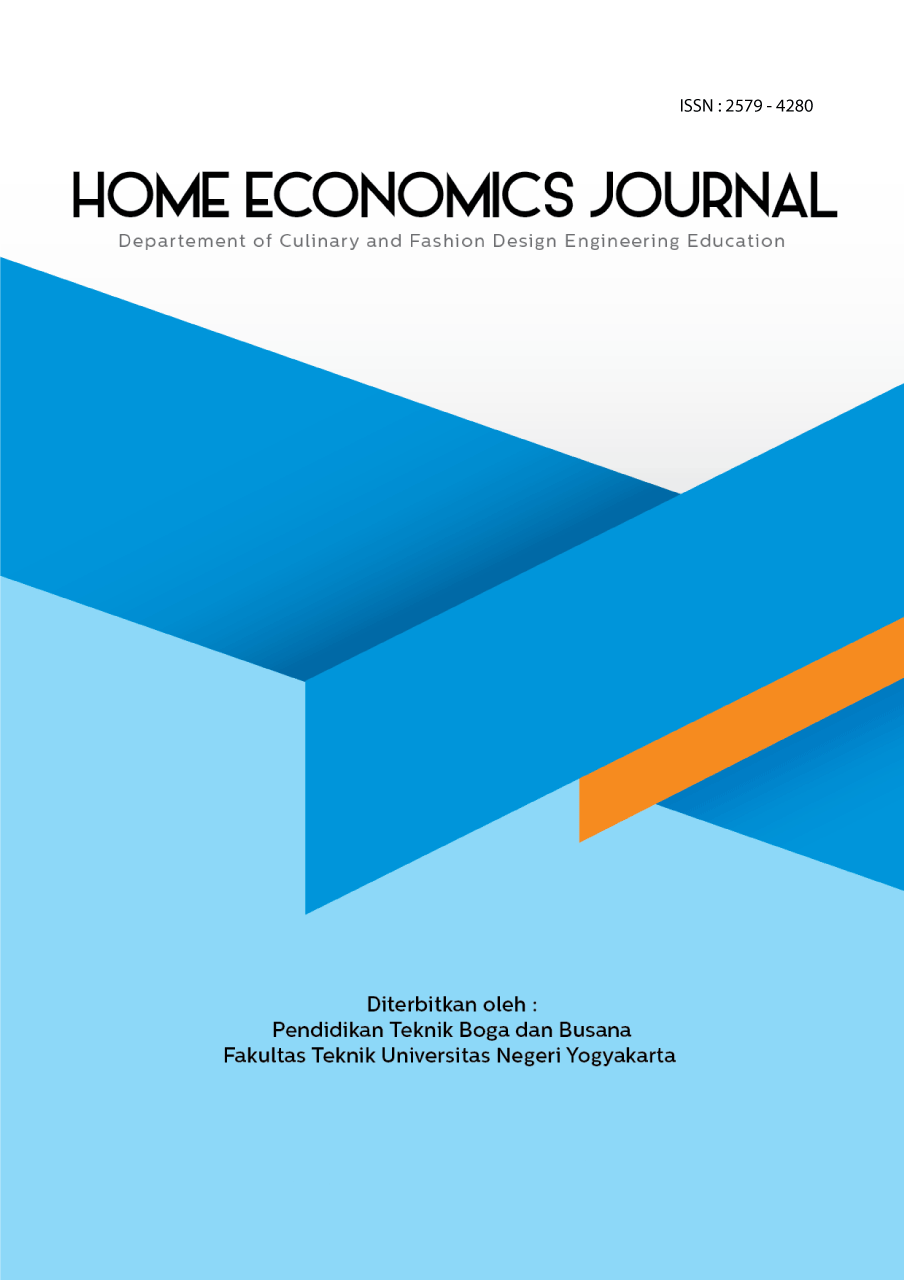THE APPLICATION OF SWAN IDEA SOURCE ON BRIDAL FASHION
DOI:
https://doi.org/10.21831/hej.v8i2.76247Keywords:
Swan feather, manipulating fabric, bridal fashionAbstract
References
K. N. P. E. S. K. Anak, "Eksploitasi Seksual Komersial Anak di Indonesia," Medan, Restu Print. Indones. hal.57, vol. 21, no. 1, pp. 33–54, 2008, doi: 10.21831/hum.v21i1. Available: https://scholar.archive.org/work/a3mjph7zgrchfhdz5bah2o66de/access/wayback/https://journal.uny.ac.id/index.php/humanika/article/download/38075/pdf_1
S. Rohmah, F. Rahayu, and S. Widarwati, "Busana Pesta Malam Dengan Sumber Ide Mobil Packard," 2023. Available: https://journal.uny.ac.id/index.php/ptbb/article/view/59003
S. Rahudhah and M. Kharnolis, "Penerapan Ragam Hias Keker pada Busana Pengantin dengan Tema Queen of Peacock," BAJU J. Fash. Text. Des. Unesa, vol. 2, no. 2, pp. 78–86, 2022, doi: 10.26740/baju.v2n2.p78-86. Available: https://doi.org/10.26740/baju.v2n2.p78-86
putri Kurniawati, "Angsa Sebagai Ide Dasar Penciptaan Motif Batik Yang Diaplikasikan Pada Busana Luaran Wanita," Univ. Nusant. PGRI Kediri, vol. 01, pp. 1–7, 2017. Available: https://doi.org/10.33153/texture.v3i2.3273
T. D. Unesa, "Journal of Fashion & Textile Design Unesa," vol. 3, pp. 1–10, 2022. Available: https://doi.org/10.15294/teknobuga.v9i1.24741
Min, S., DeLong, M., & LaBat, K. (2015). Exploring flow in the apparel design process. International Journal of Fashion Design, Technology and Education, 8(3), 260–267. Available: https://doi.org/10.1080/17543266.2015.1093179
Hall, M. L., & Lobo, M. A. (2018). Design and development of the first exoskeletal garment to enhance arm mobility for children with movement impairments. Assistive Technology, 30(5), 251-258. Available: https://doi.org/10.1080/10400435.2017.1320690
R. A. R. Fernandi and C. Ruhidawati, "Penerapan Ruffles Sebagai Manipulating Fabric Pada Busana Pesta," TEKNOBUGA J. Teknol. Busana dan Boga, vol. 9, no. 1, pp. 26–32, 2021, doi: 10.15294/teknobuga.v9i1.24741. Available: https://doi.org/10.15294/teknobuga.v10i2.31825
J. Teknologi, B. Dan, and D. Nur, "Visualisasi Naga Erau pada Hiasan Busana Pengantin Wanita Muslim," vol. 10, no. 2, pp. 131–139, 2022. Available: https://doi.org/10.26740/baju.v3n2.p48-56
Atasoy, B., & Martens, J. B. (2016). STORYPLY: designing for user experiences using storycraft. In Collaboration in Creative Design: Methods and Tools (pp. 181-210). Cham: Springer International Publishing. Available: https://link.springer.com/chapter/10.1007/978-3-319-29155-0_9
T. D. Unesa, "Journal of Fashion & Textile Design Unesa," vol. 3, pp. 48–56, 2022. Available: https://doi.org/10.15294/teknobuga.v9i1.26010
D. A. N. Tekstil, "Journal of Fashion & Textile Design Unesa," vol. 1, pp. 128–137, 2020. Available: https://doi.org/10.26740/baju.v1n1.p57-72
I. Indarti and A. Wati, "Penerapan Seamless Tucks pada Busana Pesta dengan Tema The Gray Hole," vol. 9, no. 1, pp. 7–13, 2021. Available: https://doi.org/10.26740/baju.v1n2.p128-137
Maharani, L. T., & Erwin, E. (2020). Angsa dalam Karya Tapestri. Serupa The Journal of Art Education, 9(2), 182-188. Available: https://doi.org/10.24036/stjae.v9i2.107939
P. Busana, P. Malam, and D. Tema, "Journal of Fashion & Textile Design Unesa," vol. 1, pp. 57–72, 2020. Available: https://doi.org/10.26740/baju.v3n1.p1-10









